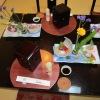With over 34 million people in Tokyo and its surrounding area, it’s amazingly well organized. Trains arrive exactly on time and you don’t see any graffiti or trash on the streets. It seems as if every person has a role to play that contributes to the collective. There’s awareness that whatever one does has an impact on everyone else.
Respect, at the core of their cultural values, is ingrained in the rituals and traditions:
Respect for others. Fundamental moral standards are woven deep into the society. Individuals have a strong sense of duty toward family, colleagues and community. Japanese hospitality, called omotenashi, is ever apparent in the hotels,
ryokans and restaurants you visit. Employees anticipate the needs and desires of each guest. This includes everything from making sure you feel relaxed and satisfied to the host’s genuine attitude and attention to details. Honestly, the service everywhere is exceptional and the series of bows you receive when you leave is humbling. Bowing back just becomes automatic.
Respect for rules. Good manners and being sensitive to other people is taught to very young children at home and in school. Fierce loyalty is valued and saving face is seen as bringing honor to oneself and one’s culture. Emotions such as anger, disappointment and sadness as well as issues like bankruptcy, divorce and addiction are considered shame-based. Unfortunately, suicide has long been a means of atoning for disgrace, defeat, or any dishonorable action.
Respect for beauty. You can appreciate the extent of the culture’s respect for harmony with nature when you enjoy a traditional multi-course dinner. It can consist of 15 different dishes, all with natural, fresh ingredients of high quality. Almost always included are miso soup, raw fish, hot pot, pickled vegetables and sake. It is said that
kaiseki is a meal at one with nature. Attentive and graceful women in kimonos serve you and the presentation is breathtaking. The food is creative, often adorned with flowers and leaves. With many different tastes and textures, it’s served in tableware of various colors, shapes and designs.
In recent disasters, the Japanese people have persevered, remaining civil and considerate while enduring impossible hardships. This is known as gaman, a Zen Buddhism principle, that means enduring the seemingly unbearable with patience and dignity. It has been variously described as a law, a virtue, a trait or an attitude.
Helping others and suffering selflessly are at the core of Japan’s national character. Which raises some questions about our culture. When do we subsume our individual interests for the common good? What are examples of our collective tolerance and patience? How can we better demonstrate our strength and caring in the face of crisis? It gives us a lot to think about.
 Looking over my photos from a recent trip to Japan got me thinking about this centuries-old culture. It is a beautiful country with a certain set of characteristics that make it insular, cohesive and unique. There is a tight-knit social fabric, with no immigration and the only spoken language is Japanese.
Looking over my photos from a recent trip to Japan got me thinking about this centuries-old culture. It is a beautiful country with a certain set of characteristics that make it insular, cohesive and unique. There is a tight-knit social fabric, with no immigration and the only spoken language is Japanese.






